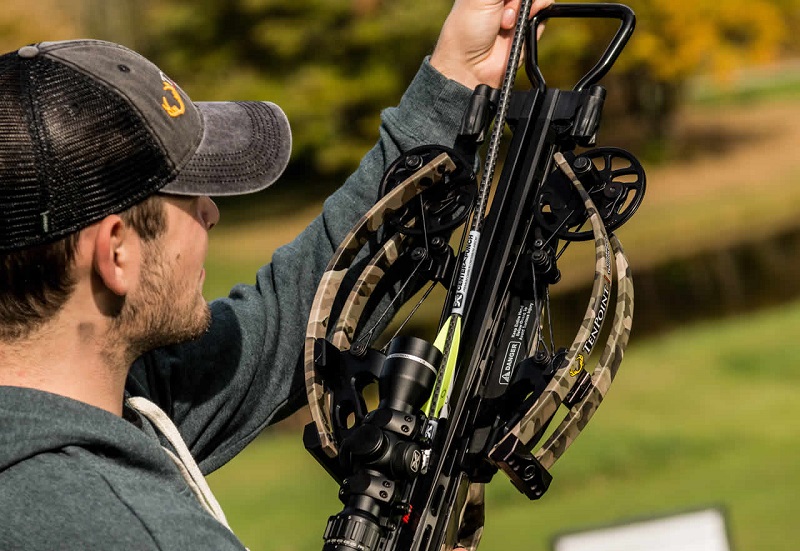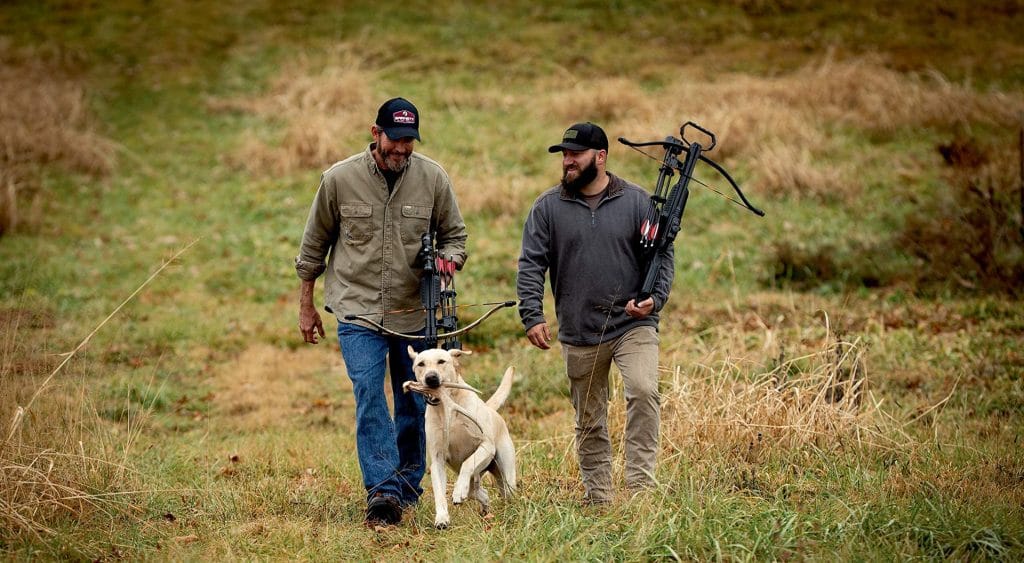

From the Battlefield, The Walking Dead, to the Game of Thrones, the crossbow is everywhere. Used for millennia, the crossbow is an essential tool for archers, sportsmen, and warriors. It is a string weapon consisting of a bow and a barrel.
This practical and silent archery weapon is a beautiful object steeped in history. It is very useful for survival, hunting, or leisure. This tool has survived the test of time and is experiencing an evolution.
Today, it is considered a sports article in its own right. To be able to fully enjoy archery, either as a professional or as a hobbyist, it is essential to know how to handle it correctly to produce accurate shots.
Be sure to read the rest of this article to better understand how this weapon works and how to shoot a crossbow accurately.

It is a combat weapon that is mechanically designed mainly to shoot arrows. It makes use of moving parts to project arrows, instead of drawing the bowstrings manually to shoot, as you can find in traditional bows.
Its design is similar to that of a bow, but it is smaller and is fused with a straight base, which contains the trigger and other components. The bow is the support of the ammunition to be fired and it distributes all the pressure so that it can be fired. In addition to this, there is a small pulley to adjust the tension with which the arrow will be held.
This weapon is mainly recognized for its accuracy and reduced rate of fire. The crossbow is characterized by its great power and ease of firing. Also, it is particularly quiet.
As a tool that combines both the different mechanisms of the bow as well as of the rifle, to achieve accuracy with the crossbow, the necessary steps include cocking and loading the bow, aiming, and then shooting.
There are currently three main types of crossbows that are on the market for sport and recreational shooters as well as hunters.
Just like the compound bows, the compound crossbows generate the greatest power.
Similar to the compound bow, they were originally developed for hunting. They are still mainly used for this activity today. But they are also becoming increasingly popular for shooting targets in sports and entertainment.
Due to its less complex construction (no cams and cables) and its lower prices, a traditional crossbow is more suitable for the entertainment sector.
But there are also high-quality models in this area. In terms of price, however, these are in the upper price segment (from around $300).
Handy and effective, the pistol crossbow is entertaining and ready for immediate use. Pistol crossbows make it possible to shoot precisely at short distances with small bolts.
It is not as accurate as the “big” crossbows due to the missing shoulder stop. The weapon however belongs to the fun area, but it is occasionally used in competitions.
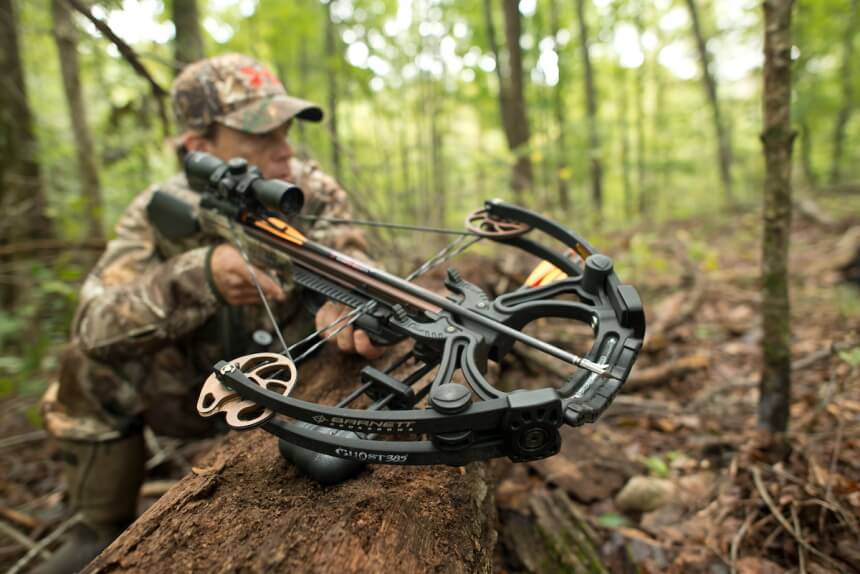
When the trigger is pulled, the crossbow chain is released and jostles the front bolt at high speed.
Contemporary crossbows can shoot up to 405 feet per second which is the equivalent of around 276 mph. This speed comes from the draw of the bow.
A crossbow also has the possibility of having a shorter bow compared to those of the bow. However, the kinetic energy is much stronger, because of the heavy nature as well as the use of mechanical systems to keep the bolt in place.
The crossbow variations consist of recurve crossbows, which carry more power. However, they are more deafening and can add more interest to the crossbow parts.
Compound crossbows require less force to hold them, as the pulley system is similar to that of compound bows. On the other hand, the pulleys exert more work due to the addition of the speed of the screw when the trigger is pulled.
In archery, the directing eye is more important than the dominant hand, because it is the eye that allows you to aim and estimate distances. To determine which eye is your directing eye, point your finger at a far wall or object, and close one of your eyes.
If you have the impression that your finger is suddenly moving from one point to another, you have just closed your directing eye.
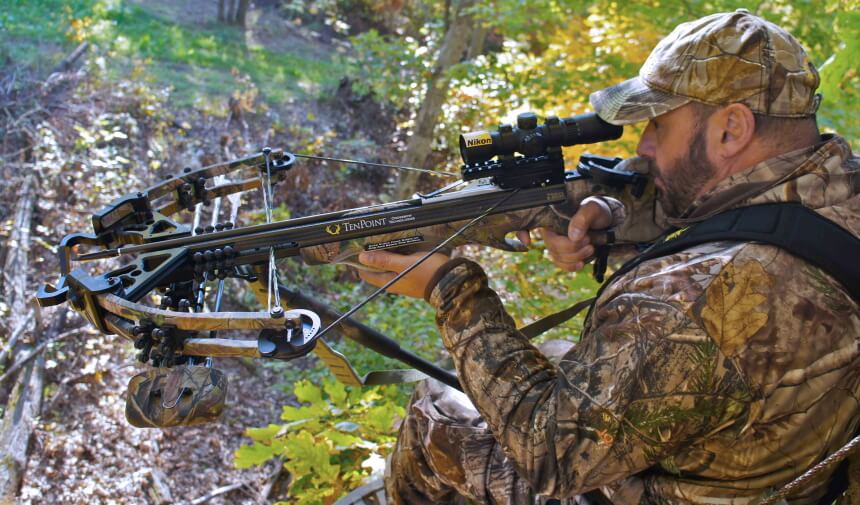
In general, crossbows can be wielded with any hand.
Buy some to shoot with a bow. If you have a crossbow, look for bolts with the length, density, and type of notch recommended by the gun manufacturer.
For a recurve bow, look for arrows that are about two inches longer than your drawbar. If possible, buy good quality arrows made of carbon fiber, aluminum, fiberglass, or wood.
If you want to shoot at a practice target, use target tip arrows. If you want to hunt, use broadhead or parabolic arrows. You can also use Judo points. They have small hooks that catch on the prey when you touch it.
To determine your draw, bring the string back as if you were going to shoot a bow and have someone measure the distance from the back of the string to the front of the bow at the arrow rest.
There are certain items that you absolutely must use to ensure your safety and comfort when doing archery. Look for a bracelet to cover your bow arm and protect it from the string. Look for a plastic breastplate to protect your chest from the friction of the string. Then you need a glove or paddle to avoid injuring your fingers with the string, and a quiver for arrows.
The most important is the glove or pallet. Without this protection, you can permanently injure your nerves, even with a 20-pound arc. You are strongly advised not to shoot a bow with your bare hand.
To practice archery, you need to use your personal target. They come in a variety of forms, including bags that are effective for single point arrows, foam plates that can be used for broadheads or notches, or even 3D targets of animals, zombies, etc. In addition to targets, consider purchasing training items like:
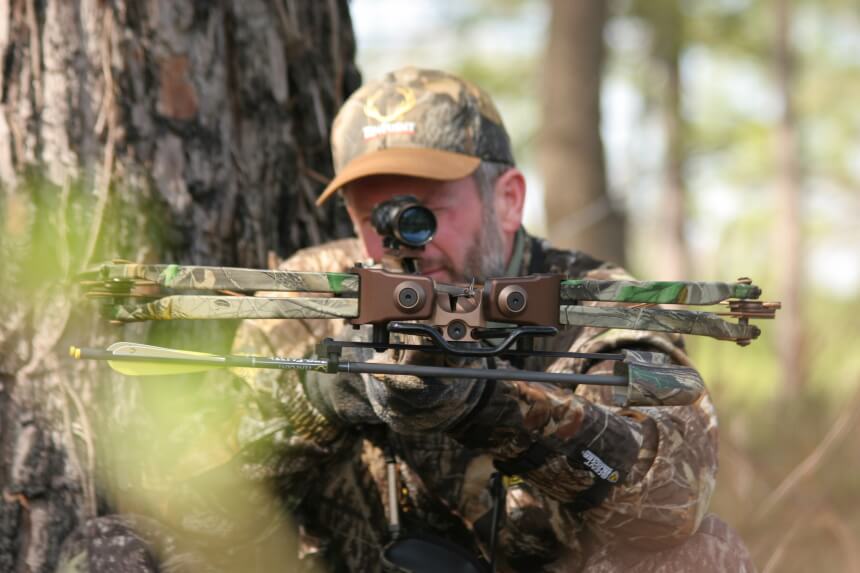
Do this by bringing the rope back. If you are using a hand-cocked crossbow, put your foot in the stirrup on the front of the weapon and pull the string back until it is held by the nut.
Make sure that both sides are as equal in length as possible. If the cocking is done using a crank, attach the crossbow as needed. Then simply rotate it until the bow is drawn and the string is held in place.
Once you have bent the arc, put a tile in the slide by inserting the rooster feather into the groove. For your safety, always install the bolts from above, keeping your hand well away from the front of the weapon and its main mechanism.
Raise the crossbow to your dominant shoulder, much like using a rifle, and wedge the stock into the crook of your shoulder or just rest it on it.
Support the weapon from below with your non-dominant hand to stabilize it by keeping your fingers away from the mechanism. Never attempt to shoot with one hand, as your shot will not be accurate and could be dangerous.
If you handle the crossbow with one hand without supporting it with the other, it can be very dangerous and lead to serious injury.
Use the viewfinder or eyecup. If the weapon is equipped with a sight, look through it, and line up the center of the reticle with the target. Check the viewfinder manual to make sure you know what the reticle lines mean. If your crossbow does not have such an accessory, aim at the target using the eyecup or other aiming element of the weapon.
When you are ready to shoot, hold the crossbow so that it is still and check its alignment using the sight or eyecup. Then pull the trigger like it were a rifle. When the tile leaves, the trigger will make a small popping sound.
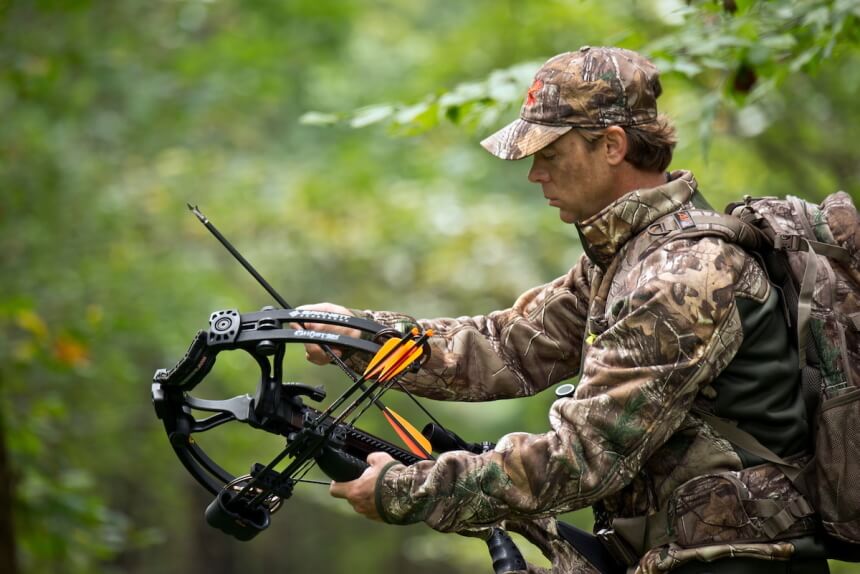
When you want to shoot, position yourself so that an invisible line from the target and perpendicular to it passes through your two feet.
If your directing eye is the right one, then you’ll have to hold your bow with the left hand. Next, point the left shoulder to your target. Then, manipulate your arrow while stringing with the right hand. However, if your leading eye is the left, do the reverse.
Stand up straight with your feet apart by a shoulder-width. Squeeze the gluteal muscles to move the pelvis forward. Keep your back straight so that it forms a T with your arms and shoulders as you pull the bowstring.
Your posture should be comfortable enough that you can maintain it for a long time, but it should still be firm and dynamic.
Point the front of the bow towards the ground. Then let the arrow tube rest on your arrow rest. Tie its back end to the bowstring using the plastic notch there. If the arrow has three valves (the feathers at the back end), position it so that only one valve is pointing outward from the bow. Place the notch below the notch mark. If there are two marks, position the notch between the two.
Hold it on the string with three fingers. If you’re shooting with a sight, let the index finger be above the arrow. Then let the ring and middle fingers be below. This is called the “Mediterranean catch”.
If your bow does not have a sight, position all three fingers under the arrow so that it is closer to your eye. By using your thumb, support the arrow at the back while keeping it straight.
Keeping your fingers on the string, lift the weapon, and extend it towards the target. The inside of your elbow has to be on a level as the ground. Then the arch should remain vertical. If you hold it correctly, your gaze should follow the top of the arrow tube.
Use your three fingers to bring it back to your face. Use the muscles in your back for strength while keeping the arm in a relaxed way. Pull until the string feels very tight, then choose your chin, ear, or another part of your anatomy as a reference point so that you can bring the notch of the arrow back to the same point each time you pull. Then ensure you tighten the rope as much as possible.
Your shot will have more precision and you will reduce the impact of wind and gravity.
Raise your elbow as you pull the rope back to work the muscles in your shoulders, not your arms.
Simply unfold the fingers holding the string. The goal is to make the arrow shoot cleanly. For this, the rope must leave your hand as quickly and with as little discomfort as possible.
It might sound simple to you, but the way you let go of the string can impact the trajectory of the arrow. The slightest movement or trembling can cause it to deviate. After unchecking it, wait for it to hit the target before lowering the arc.
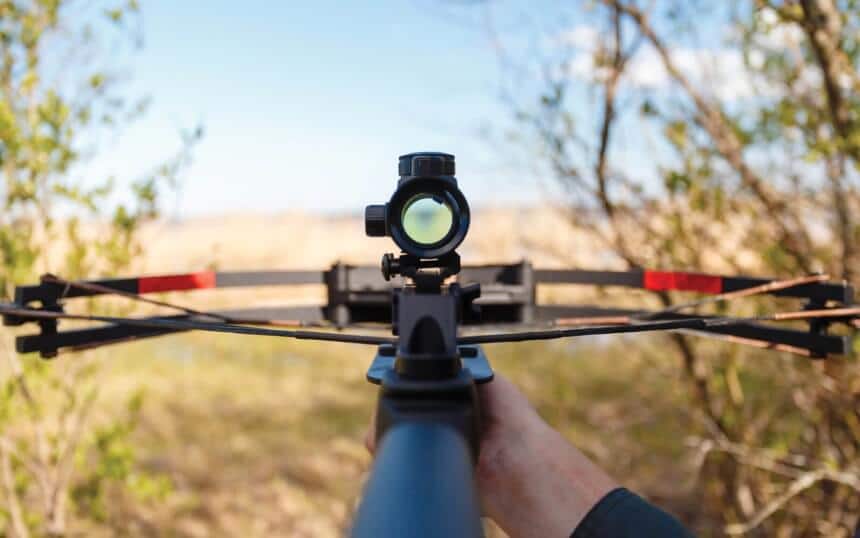
There are two types of foot posture. These are the square foot position and the open foot position. The two positions are what you will have to work on when executing a shooting sequence.
Although both are correct, the one that offers the best posture and solidity to our anchor is the open position. It consists of, if you are right-handed, moving the outer (right) foot forward a little with respect to the inner (left) foot, placing it perpendicular to your goal.
This way, you get a small twist of the spine, making the back-spine set more solid.
Maintain tension to the wall, with relaxed hands, and let the release occur without any conscious intervention.
To improve your accuracy, always aim at the target. Most amateur archers employ a technique called “instinctive shooting”. It simply consists of orienting the arc to align the tip of the arrow with the target.
If you want to aim more accurately, you can purchase an adjustable sight that mounts to the front of the bow. When shooting, you can close your non-guiding eye or keep both eyes open.
Do not advance your hand to try to give momentum to the arrow when shooting. For the best possible shot, stay perfectly still.
Observe the recoil of the bow during the release, as it may indicate problems with posture or technique.
A crossbow is a weapon of choice intended for hunters who like the impression of an arrow and want the convenience of using a firearm. Long considered a weapon, crossbows are now more popular as a sporting item.
Whether you’re doing it for fun, competing, or hunting game, you need to know how to equip the bow, aim, and shoot correctly to hit your target accurately.
Try doing pull-ups, push-ups, as well as other exercises to strengthen your arms before pulling up. This will allow you to hold the bow more easily and for the most accurate shots.
The best way to learn how to shoot a crossbow accurately is to bring in a teacher. This is because you will always have a small problem with technique or posture that is difficult to spot. But another person can correct you very easily by watching you.
Never try to pull the string and release it without an arrow, as this can cause microscopic fractures to form in the bow.
Don’t aim at a goal that you do not intend to shoot.


